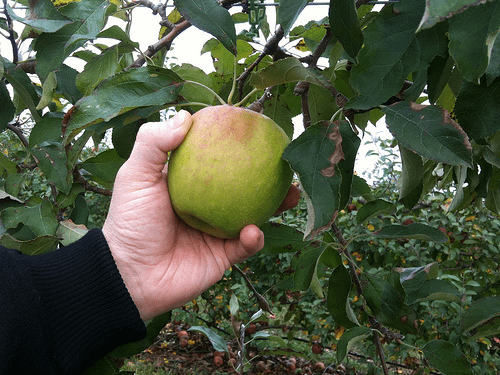Image via Flickr by kmadrid
Meet the future of orchard farming. As in many other industries, advances in technology are ushering in a new era of planting and harvesting fruit. Machines help farmers plant more fruit, irrigate, and harvest in less time than ever before. Other advances let farmers reduce harmful pesticides through breeding techniques. Let’s take a look at what’s new in the orchard industry.
RELATED ARTICLE: HIGH TECH FARMERS NEED HIGH TECH REPAIRS
Big Changes in Harvesting
One of the biggest changes is using machines to pick the fruit efficiently and safely. For large corporate orchards, machines lift workers up to safely pick the fruit, and a series of vacuum hoses transfers the fruit into bins already on trucks. This still means a person picks the fruit off the tree, but the machine reduces the need for baskets and wobbly ladders.
Smaller orchards use boom lifts to help workers reach those higher branches while in a secure bucket. Ironically called cherry pickers, you see these lifts used by construction and utility workers a lot. Powered by hydraulic mechanisms, the operator controls the position of the bucket, allowing for easy access to high hanging fruit. And the best part is, you can rent a boom lift just for harvest time, meaning no large capital outlay for a harvesting machine.
Changing Orchard Designs
To increase the yields, planting more trees seems the obvious answer. But making more room means narrower rows between trees. Previously, those paths needed width for a tractor. Today, automated sprayers attached to trellis systems cut the need for large spaces between rows. By narrowing the gap, farmers can plant trees closer together, increasing density from around 1,000 trees per acre up to 1,300 trees per acre. The automated system uses irrigation lines underground and nozzles placed strategically along the trellis.
Growing trees no longer involves planting seeds and waiting years for the fruit. Today trees grow from tissue cultures instead, basically cloning the tree. This technique allows the tree to reach full yield potential in only 3 to 4 years. Further genetic advances might include water-efficient trees, insect-resistant trees, and trees that produce more nutritious fruit. Also, since trees reach maturity earlier and at similar times, farmers need only a single harvest per season.
The Cost of Technology
Unfortunately, changes in technology are not cheap. Many of the automated processes are beyond the reach of small growers due to price. For the large, corporate-owned orchards, technological advances help these farms become highly efficient. But corporate farms tend toward growing less variety.
Therefore, smaller farmers need not worry. Consumers increasingly look for locally grown produce, and regional orchards continue to offer variety through farmers’ markets and local grocery stores. Many restaurants also choose locally grown produce.
Modern technology involves other changes as well. Over-the-row equipment for spraying, pruning, and harvesting allows farmers to plant trees closer together, thus growing more fruit per season. Other future goals include solar-powered and GPS-operated machines for weed control, and solar-powered LED systems for more light.
As the modern world changes and becomes more efficient, technology touches every industry. Even the simple act of growing an apple.


